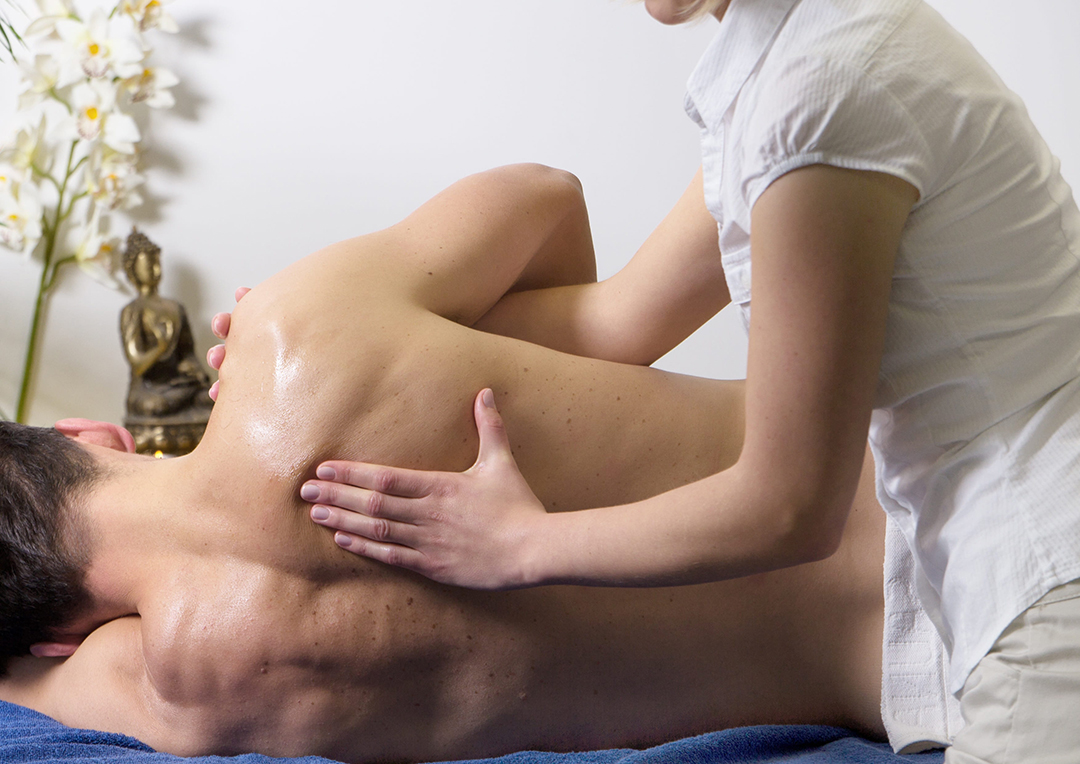Massage therapy images typically show clients on their backs or bellies, but a side-lying position provides many unique advantages. For instance, those who suffer back or neck pain may find the side lying position to be the most comfortable option for massage treatment. After reviewing the benefits of this underutilized massage treatment position, we suggest practical tips for LMTs who would like to offer side-lying positioning to clients.
6 Benefits of Side-Lying Position for Massage Therapy
1. Client Comfort. Many clients, particularly those with back pain and/or large, sensitive breasts will feel most comfortable lying on their sides. Offering carefully positioned bolsters and pillows can help increase comfort even further in a side-lying position.
Those with respiratory challenges may also find side-lying more comfortable. Breathing discomfort can arise from prone and supine postures. The too-familiar sounds of sniffling and snorting are signs that clients’ sinuses are backing up due to traditional massage positioning. The side-lying position allows for increased respiration, increasing the efficacy of massage treatment. Overall, side-lying is excellent for those with respiratory conditions, such as asthma, allergies, or colds.
2. Safe Prenatal Massage. Pregnant people are classic candidates for side-lying massage, as their growing bellies do not allow prone positioning, and supine postures are not safe for fetal circulation. Moreover, downward pressure in a prone position may actually exacerbate the ligament pain many pregnant individuals experience. Just as gestating individuals are advised to sleep on their sides, the side-lying position is best for receiving massage therapy.
3. Ease for Elderly, Frail, and Medically-Affected Clients. Older clients, as well as those who are frail, are more likely to be comfortable in a side-lying position because it causes less table pressure on sensitive skin and joints. Additionally, those with implanted medical devices, or who are recovering from surgery, may be best treated when lying on their sides. Click here for more tips on massaging elderly clients.
4. Increased Therapist Comfort. The side-lying position allows the therapist to move close to the edge of the table, providing better leverage and access. With one whole side of the client’s body facing toward you, it is easier to maintain a neutrally upright posture. It may also be easier to keep your wrists straight, for less strain in the long run.
5. Easier to Reach Some Muscles. Muscles that run laterally are much easier to access in a side-lying position. For long, broad strokes, the therapist can use their forearms to treat these muscles, giving the hands and wrists a break.
6. Emotional Comfort. Pain is often intertwined with negative emotions and stress. More than any other position, side-lying imitates the fetal position, which many people find naturally soothing. Side-lying clients may be more likely to relax, boosting treatment efficacy.
Now that we’ve explored some of the benefits of treating clients in the side-lying posture, let’s discuss logistical concerns of doing so.
Tips for Massage Therapists on How to Provide Side-Lying Treatment
Adjust the table height. In side-lying treatment, the direction of pressure is more downward, particularly when working on the client’s hip or pelvis. In such situations, a lower height is helpful. When switching to providing more lateral pressure, such as when targeting the lower erector spinae muscles, a lift mechanism allows the therapist to easily raise the table height. If you have an adjustable table without a lift mechanism, you can set up for appointments by having the table at a height somewhere between your wrist and your knuckles when your arms are hanging at your sides.
Client Positioning. For access, avoid having your client lie in the middle of the table, and especially avoid having them on the side farthest from you. It’s best for them to be near the side of the table where you’ll be standing. To encourage that, you can line up cushions with the rear side of the table, so they’re set up to lie in the middle of the cushions, nearest you.
Weight Shifting. Maintain a more upright position by leaning into your back leg, and minimizing weight in your front leg. Then, lean your weight into your working hand/tool and into the client. This will allow you to use your body weight to create momentum.
Adjust your Gaze. Many therapists are accustomed to having their eyes in line with the client’s spine, because this is often the case when the client is in a prone position. When providing a side-lying treatment, the therapist is often inclined to tilt their head to one side to align with the spine. This can create tension in the neck and lumbar, so it’s key to keep your torso and head erect. Over time, this side-lying view of the spine will become more natural.
Table Supports. To make clients comfortable, have bolsters and pillows at the ready. Larger bellies will need underlying support. Many clients will find pillows between the legs comfortable, so that the foot, leg, and hip are all parallel to the ceiling. Additional pillows under the rib cage, arm, and lumbar spine may also be helpful, but remember every client will have their own preferences. As such, having flexible propping options–e.g., towels–is a good idea.
Massage Therapy Continuing Education for Side-Lying Treatments
Wherever you provide services, from Paris to Portland, massage therapy results are only as good as your training and experience. That’s why access to high-quality continuing education classes is crucial. Here in Portland, LMTs can stay up-to-date and hone their skills through East West College of the Healing Arts. At any given time, we offer a plethora of courses to pique your professional curiosity. Currently, we have an upcoming CE course on Thai massage techniques which includes options for side-lying treatment. Of course, we like to keep things fresh with new classes every quarter. Check out and sign up for upcoming classes at the East West College Continuing Education site.
Resources:
The Benefits of Using Side-Lying Positioning – Carole Osborne
The Advantages of the Side-Lying Client Position – Laurianne Green
Carole Osborne: Addressing Body Mechanics While in the Side Lying Position
East West College CE website




